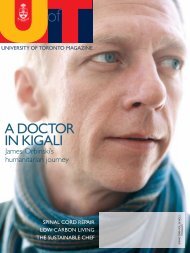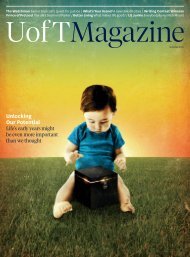What's the solution to Toronto's traffic problems? - University of ...
What's the solution to Toronto's traffic problems? - University of ...
What's the solution to Toronto's traffic problems? - University of ...
You also want an ePaper? Increase the reach of your titles
YUMPU automatically turns print PDFs into web optimized ePapers that Google loves.
ight itself: <strong>the</strong> activations more closely resembled what happens<br />
in healthy people. “They were closer <strong>to</strong> normal after <strong>the</strong><br />
training,” says Ross. The researchers’ work will be published<br />
in <strong>the</strong> Annals <strong>of</strong> <strong>the</strong> New York Academy <strong>of</strong> Sciences.<br />
atients who make music or sounds seem <strong>to</strong> recover<br />
better, but those who “feel” sound vibrate through<br />
<strong>the</strong>ir body might also improve. This is a line <strong>of</strong> inquiry<br />
being pursued by Heidi Ahonen, a psycho<strong>the</strong>rapist and<br />
pr<strong>of</strong>essor <strong>of</strong> music <strong>the</strong>rapy at Wilfrid Laurier <strong>University</strong> in<br />
Waterloo, Ontario, who will also be affiliated with U <strong>of</strong> T’s<br />
Music and Health Research Collabora<strong>to</strong>ry.<br />
Ahonen has been working with a special “physioacoustic”<br />
chair, designed and first used in her native Finland. At first<br />
glance, it looks like an ordinary recliner. But it’s fitted with<br />
six loudspeakers, one behind each knee, two in <strong>the</strong> lower<br />
back area and two in <strong>the</strong> shoulder area, which work <strong>to</strong>ge<strong>the</strong>r<br />
<strong>to</strong> circulate vibrations evenly around <strong>the</strong> body. The speakers<br />
are hooked up <strong>to</strong> a computer and s<strong>of</strong>tware, which allows<br />
Ahonen <strong>to</strong> choose <strong>the</strong> exact frequency she wants, usually<br />
around 30 Hz – a very low-frequency sound that’s barely<br />
audible. It is believed that <strong>the</strong> vibrations can be made<br />
<strong>to</strong> resonate with <strong>the</strong> muscle or tissue that <strong>the</strong> practitioner<br />
is trying <strong>to</strong> treat.<br />
The physioacoustic chair so far has not been approved<br />
for medical use in Canada, but <strong>the</strong> U.S. Food and Drug Administration<br />
has sanctioned it for three treatments: reducing pain,<br />
improving blood circulation and relaxing muscles. Elsewhere<br />
in <strong>the</strong> world <strong>the</strong> chair is used for stress relief, drug rehab and<br />
psycho<strong>the</strong>rapy, among o<strong>the</strong>r things. Many <strong>of</strong> Ahonen’s own<br />
private clients from a previous practice in Finland came <strong>to</strong><br />
see her about pain – post-surgical pain, for instance, or fibromyalgia<br />
– but some also seek relief for o<strong>the</strong>r ailments, such<br />
as Alzheimer’s disease and <strong>the</strong> damage caused by stroke. So<br />
Ahonen was enthusiastic when Quincy Almeida, a neuroscientist<br />
at Wilfrid Laurier <strong>University</strong> interested in Parkinson’s<br />
disease, approached her <strong>to</strong> collaborate in a study on whe<strong>the</strong>r<br />
<strong>the</strong> chair could improve <strong>the</strong> disease’s symp<strong>to</strong>ms.<br />
Parkinson’s disease is a neurological disorder caused when<br />
brain cells that produce dopamine are slowly destroyed.<br />
This results in tremors, as well as difficulties with walking,<br />
movement and co-ordination. Scientists don’t know exactly<br />
why <strong>the</strong> chair might help relieve <strong>the</strong>se symp<strong>to</strong>ms but some<br />
have <strong>the</strong>orized that certain frequencies <strong>of</strong> vibration might be<br />
stimulating part <strong>of</strong> <strong>the</strong> brain involved in Parkinson’s.<br />
Forty Parkinson’s patients participated in Ahonen and<br />
Almeida’s study. It compared <strong>the</strong> effectiveness <strong>of</strong> treatment<br />
versus just relaxing in <strong>the</strong> chair. Each participant did both;<br />
half rested first, and half had <strong>the</strong> treatment first. For <strong>the</strong> treatment,<br />
Ahonen exposed <strong>the</strong> patients <strong>to</strong> <strong>the</strong> low-frequency<br />
30Hz vibration for one minute, followed by a one-minute<br />
break, in alternation for a <strong>to</strong>tal <strong>of</strong> just 10 minutes. For <strong>the</strong> rest<br />
phase, <strong>the</strong> patients sat comfortably in <strong>the</strong> chair, relaxing.<br />
They were assessed in three ways. First, <strong>the</strong> patients were<br />
videotaped and rated for tremor, finger-tapping, leg agility,<br />
posture and <strong>the</strong>ir ability <strong>to</strong> stand up from a seated position.<br />
They were also asked <strong>to</strong> walk in a straight line at a normal pace<br />
down a carpet that could measure step speed and length.<br />
Finally, <strong>the</strong>y were timed while inserting and removing special<br />
keyed pegs from a board. They were assessed at three time<br />
points: at baseline, after treatment and after resting.<br />
Ratings <strong>of</strong> both rigidity and tremors improved significantly<br />
after <strong>the</strong> vibration treatment, <strong>the</strong> researchers found. So did<br />
step length. They also got pegs in<strong>to</strong> <strong>the</strong> board more quickly –<br />
taking an average <strong>of</strong> just 170 seconds <strong>to</strong> do so, compared <strong>to</strong><br />
210 seconds before <strong>the</strong> treatment. The researchers published<br />
<strong>the</strong> work in <strong>the</strong> journal NeuroRehabilitation. “It was encouraging<br />
<strong>to</strong> see changes after so short a time,” says Ahonen, “but<br />
we don’t know if it lasted. We need <strong>to</strong> do a long-term study.”<br />
How Music<br />
Gets Inside<br />
At its simplest, music is just sound. And sound is<br />
just vibration. So how does it get inside us, and<br />
influence us<br />
Through cultivated ears...<br />
Mostly when we think <strong>of</strong> music, we think <strong>of</strong> listening<br />
<strong>to</strong> it. We think <strong>of</strong> music we like and don’t like; music<br />
that settles us down or pumps us up. This way <strong>of</strong><br />
being affected by music is known as a “learned cognitive<br />
response.” It has a cultural component, but<br />
<strong>the</strong>re’s no doubt <strong>the</strong> groundwork is laid in <strong>the</strong> womb.<br />
A baby hears a mo<strong>the</strong>r’s heartbeat, and learns early<br />
on that <strong>the</strong>re’s a connection between arousal and an<br />
increased rhythmic pulse. Hormone release, oxygenation<br />
and mood can all be affected.<br />
The back roads <strong>of</strong> our minds...<br />
Alzheimer’s patients, who can’t recognize <strong>the</strong>ir own<br />
children, can sometimes remember and sing along <strong>to</strong><br />
hymns <strong>the</strong>y learned as kids. People who stutter in<br />
normal conversation can sometimes sing seamlessly.<br />
Music, it appears, <strong>of</strong>fers a secondary route within<br />
<strong>the</strong> brain, accessing language and memory areas<br />
using back roads, when <strong>the</strong> primary route is blocked.<br />
The beat goes in...<br />
Ever find yourself tapping in time <strong>to</strong> <strong>the</strong> music Walking<br />
in step with an industrial hammer Rhythms like<br />
<strong>the</strong>se can drive neural firing, a process sometimes<br />
called “entrainment.” Once captured by <strong>the</strong> rhythm,<br />
it can potentially alter our brainwaves.<br />
Our cells listen, <strong>to</strong>o...<br />
The human body has several recep<strong>to</strong>rs sensitive <strong>to</strong><br />
sound: audi<strong>to</strong>ry hairs in our ears, mechanorecep<strong>to</strong>rs<br />
in our skin and sound-interested neurons scattered<br />
throughout our brains. All <strong>of</strong> <strong>the</strong>se areas need more<br />
study, but a growing field is vibroacoustic <strong>the</strong>rapy,<br />
where low-frequency sound is applied <strong>to</strong> <strong>the</strong> body in<br />
order <strong>to</strong> heal it. – ALISON MOTLUK<br />
summer 2012 29

















